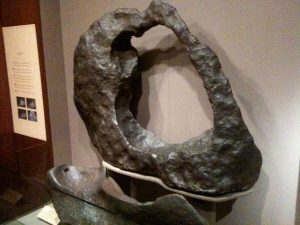Mysterious Meteorite Part of Tucson History
by Ken Scoville
"The story of the Tucson Meteorite has been ongoing since the 1840s and is unique in that it combines early historical accounts, the military’s arrival in the early 1860s, the Smithsonian Institution, the astronomy community, the gem and mineral show, and the archaeological search for the presidio. The quest to find the impact location of two meteorite fragments in the Santa Rita Mountains is reminiscent of the search for the Lost Dutchman gold mine in the Superstition Mountains near Phoenix.
Archaeological excavations in March and April of 1998 were conducted in various locations where the presidio wall and other resources were believed to still exist. Just west of City Hall and south of Alameda the dig uncovered what might have been a section of the presidio wall and a wall from a later structure, depicted on the earliest map of Tucson (1862 Fergusson map). The artifacts located inside the structure coincided with materials one would expect to find at or near a blacksmith’s shop. These materials included a netherstone or small anvil, scraps of brass and slag. This location is also near where historical accounts placed the Presidio blacksmith using the “ring meteorite” as an anvil. This is one of two fragments of the Tucson Meteorite with the other smaller fragment (Carleton meteorite) used by another blacksmith at a location just to the west. The very public function of blacksmiths made these very unique anvils something to remember for earlier visitors to Tucson and tempting items to be confiscated.
The early accounts of these meteorites begin circa 1845 with a mention by J. F.Velasco in Noticias Estadísticas del Estado de Sonora: “Between the presidio of Tucson and Tubac, there is a sierra [mountain range] called de la Madera [Timber] and Puerto de los Muchachos [Mountain Pass of the Children]. In it are seen enormous masses of virgin iron, many of which have rolled to the foot of said range. From the masses, a middle-sized one was taken to Tucson, where for many years it has remained in the plaza of said presidio.” By the early 1850s two meteorite anvils are mentioned: the ring used by the military blacksmith (armorer) and the other being used by civilian blacksmith Ramón Pacheco. The last armorer during the Mexican era was Antonio Comadurian who was the son of the commander. The transfer of power between Mexican troops to American forces became the major catalyst for removal and preservation of these masses of “virgin iron.” There was even a sketch of the ring done in 1852 by John Russell Bartlett while in Tucson during an expedition to establish a boundary between the United States and Mexico as part of the Treaty of Guadalupe of 1848.
The ring meteorite used by Comadurian began its journey to the Smithsonian thanks to U.S. Army medical officer Lt. B.J.D. Irwin’s intervention during the late 1850s. “I found the large meteorite lying in one of the by-streets, half buried in the earth, having evidently been there a considerable time. No person claimed it, so I publicly announced that I would take possession of it in behalf of the Smithsonian, and forward it wherever the opportunity afforded. Mr. Palatine Robinson, near whose house the iron was, assisted me in getting it sent to Humosilla [Hermosillo].” This began a long journey to the Smithsonian via the Isthmus of Panama; the meteorite arrived in Washington D.C. in 1864.
The other fragment of the Tucson meteorite that was used by the civilian blacksmith Ramón Pacheco was confiscated during the turbulent time of the early 1860s when Tucson was taken over by Confederate soldiers soon after their arrival on February 28, 1862. By May of that same year General James H. Carleton of the California Column had recaptured Tucson for the Union. He discovered the Pacheco meteorite and with all of Tucson under martial law took this anvil and had it sent to San Francisco. This journey to the Smithsonian was even more convoluted with questions of ownership, and the Pacheco meteorite did not become a part of the collection with the ring meteorite until 1941.
The Ring Meteorite would return twice to Tucson after being away for more than a century. The first visit would be for the 1972 Gem and Mineral Show, after much arm-twisting by the Tucson Gem and Mineral Society to get the Smithsonian Institution to agree to the exhibition. Just three years later the largest known ring-shaped meteorite in the world returned for the formal opening of the Flandrau Planetarium to help recognize the importance of Tucson to the astronomy community. During this visit, local wrought-iron artist Tom Bredlow actually used the ring as an anvil. He commented that anyone who worked with iron would know in an instant that “it was heaven sent to be an anvil.”
The centennial of statehood for Arizona is only five years away and a return engagement in 2012 would seem to be in order for the world famous Ring Meteorite.”
Sources:
Scoville, Ken. "Mysterious Meteorite Part of Tucson History." Downtown Tucsonan, February 1, 2007.
Reproduced with permission from the Downtown Tucsonan
For further reading:
Willey, Richard R. The Tucson Meteorites: Their History from Frontier Arizona to the Smithsonian. University of Arizona Press, Tucson. c 1997.
Thiel, J. Homer (1998). In Search of El Presidio de Tucson. Archaeology in Tucson, Newsletter of the Center for Desert Archaeology. Vol. 12, No. 3.
Find the information you need by calling the library's Infoline at 520-791-4010 or by sending your question to Ask a Librarian.

